Six New-to-Me Trees to Consider for Planting
The Amherst campus is a perfect place for a tree walk: they have been planting trees for over 100 years, and have not only some state champion trees, but at least one national champion. Mike Dirr, a UMass graduate, has been consulting with the landscape personnel for years. Here are 6 trees I did not know, but am considering for use in my own gardens.
- Three flowered maple (Acer triflorum). I had never seen one before, and although it is available in some nurseries, it is not common. Hardy to Zone 4 (minus 30 degrees). It is a small maple, up to 20 or 30 feet tall and wide with great fall color. The exfoliating bark is interesting, giving the tree winter interest. It gets its name from its yellow-green spring flowers that come in clumps of three. This would be a nice street tree.
- Amur maackia (Maackia amurensis). This is another small tree, getting to be about 30 feet tall and 20 wide. It has an upright form with glossy dark green compound leaves. One of its main virtues is that blooms when many other trees are done blooming – probably in July in New England. The flowers are small and white, arranged on 6-inch vertical panicles.
It is a great street tree because it will grow in any type of soil and is not fussy about soil pH. It is hardy to about minus 40 degrees.
- Tuliptree (Liriodendron tulipifera). In contrast to the trees above, this is a majestic tree that has grown to be up to 200 feet tall in the wild, though generally 70 to 90 feet in cultivation. It has a strong straight trunk. I first fell in love with it in New York City’s Central Park. One planted by George Washington is still alive at Mt. Vernon, and both he and Jefferson loved this tree.
The leaves are tulip-shaped and up to 8 inches wide. The flowers appear in late spring and are yellow tinged with orange in the center, 3 inches in size. According Dirr’s new book, it is unfortunate that the flowers appear so high up, as they are difficult to see. I have used the seed pods as Christmas tree decorations.
What I had never seen before is the cultivar ‘Emerald City’ which is a smaller and hardier version of the classic. Although it can grow to 55 feet tall and 25 to 30 feet wide, Mike Dirr said in our climate it will probably not exceed 30 feet tall, and is hardy to as much as minus 35.
- Persian ironwood or Parrotia (Parrotia persica). This is another small tree (to 30 feet), one that can be multi-stemmed or single-stemmed. The tree I saw on the tour was single-stemmed and had wonderful mottled bark. The bark would be enough to make the tree a worthwhile investment – after all, flowers last but a moment, and we have many months of winter without leaves.
Parrotia blooms very early, in late winter at the time some witchhazel are blooming. The blossoms are small, and without petals according to Dirr’s book. They appear as “clusters of maroon-red stamens along the branches, bringing cheer to the cold dreary landscape.” In the fall the leaves often show yellow, orange, red and purple. Leaf borders in spring can be tinged with purple. Hardy to Zone 4.
- Swamp white oak, columnar varieties (hybrids of Quercus bicolor). Mike Dirr suggested to the landscape staff at UMass Amherst to plant some columnar oaks about 6 years ago in front of Herter Hall, and a variety of them are quite remarkable now, already reaching to 25 or 30 feet tall, but only 8 to 10 feet wide.
My favorite of the columnar oaks is ‘Beacon’, one called “Bonnie and Mike”, named after Dirr and his wife. It is one they discovered and introduced to the trade. It will grow to 50 feet but stay just 15 wide. Lovely foliage.
- Japanese snowbell (Styrax japonicus). This would be my first choice for a new tree on my landscape but it is only hardy to Zone 5 (minus 20, so it is “iffy” for me. It apparently has lovely fragrant white flowers in spring. It grows well in sun or part shade, and grows to 30 feet tall and 35 feet wide, though it grows just a foot or two per year.
But the selling point for me is the bark: “gray-brown, smooth, sinewy, developing irregular, orange-ish brown, interlacing fissures” according to Dirr’s new book.
I remember interviewing Tasha Tudor and being amazed that she was still planting trees when she was in her 90’s. So I shouldn’t hesitate to plant more trees now that I am in my 70’s. Finding the right tree and having enough space is my major challenge.
Henry is the author of 4 gardening books. You may reach him at henry.homeyer@comcast.net.





